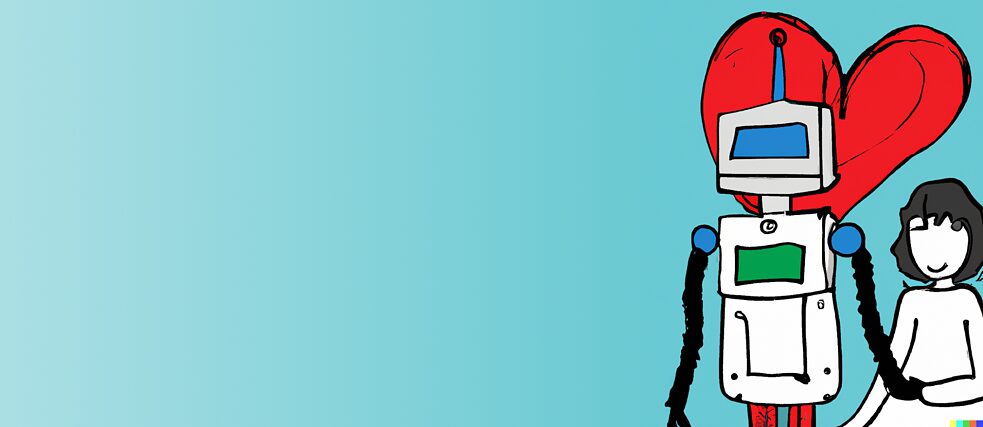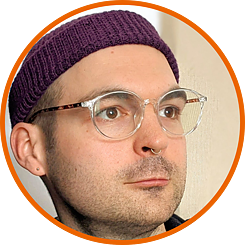The Montreal Collective behind "Robot in Residence"
The Weight of a Society of Spectacle

In this interview, learn about the resident leader’s individual work in relation to NAO as well as their collective experience during the residency.
By Priscilla Jolly
As a part of the global ‘Robot in Residence’ program, the Goethe-Institut Montreal has been hosting a NAO robot. Following a call for applications for the residency, the institute selected three people: Ceyda Yolgormez, Patil Tchilinguirian and Zeph Thibodeau. Ceyda is a PhD candidate who investigates machine learning and Artificial Intelligence (AI) from a sociological perspective at Concordia University. Patil is an artist who focuses on art, design, craft and technology. Zeph is pursuing a PhD at Concordia University, studying machines and their role in the nonhuman world. In the following interview, the residency leaders speak about their individual work in relation to NAO as well as their collective experience during the residency.
Ceyda, how did the residency with NAO influence your thinking about socialization and the social sphere in our lives? What role do you think AI plays in our imagination of the social and the public sphere?
 Ceyda Yolgormez
| © Ceyda Yolgormez
Ceyda Yolgormez: I think the AI conversation right now is very binary, caught in a cycle of hype and critique. This is hard to avoid in the emergence of new technologies, but honestly, AI has been around long enough that one would think this is not the case anymore. Unfortunately, there is still much money to be made, which means there is much manipulation to be suffered. I think the sociality of AI comes in myriad forms, and so we must not constrict our thinking to tabloid form in which we find most technology news, nor invest too much into futures imagined by an elite few. AI posits a possibility to bring imagination back which is very much lost under the weight of a society of spectacle. When we take for granted whatever is given to us, and when we remain on the surface of the matter, we are giving more chances for the perils of AI to dominate our lives. Rather, and our NAO project was a testament to this, can we think for ourselves? Living in a society that is robbed of their capacity to imagine, we are seeking to ignite some wonder and awe in the face of an increasingly constricting technological order. So, NAO allowed us to get rid of the veil of social robotics as given to us and create our own meanings and experiences that do not necessarily fit into the normative character of our times. So, while NAO did not change my understanding of the social, it gave me a space to indeed play out what it means to live with machine others.
Ceyda Yolgormez
| © Ceyda Yolgormez
Ceyda Yolgormez: I think the AI conversation right now is very binary, caught in a cycle of hype and critique. This is hard to avoid in the emergence of new technologies, but honestly, AI has been around long enough that one would think this is not the case anymore. Unfortunately, there is still much money to be made, which means there is much manipulation to be suffered. I think the sociality of AI comes in myriad forms, and so we must not constrict our thinking to tabloid form in which we find most technology news, nor invest too much into futures imagined by an elite few. AI posits a possibility to bring imagination back which is very much lost under the weight of a society of spectacle. When we take for granted whatever is given to us, and when we remain on the surface of the matter, we are giving more chances for the perils of AI to dominate our lives. Rather, and our NAO project was a testament to this, can we think for ourselves? Living in a society that is robbed of their capacity to imagine, we are seeking to ignite some wonder and awe in the face of an increasingly constricting technological order. So, NAO allowed us to get rid of the veil of social robotics as given to us and create our own meanings and experiences that do not necessarily fit into the normative character of our times. So, while NAO did not change my understanding of the social, it gave me a space to indeed play out what it means to live with machine others.
Patil, do you think NAO influenced your thinking about design and art? Often, imaginations of robots are functional, not aesthetic. What role do you think aesthetics can play in the integration of AI into society?
 Patil Tchilinguirian
| © Patil Tchilinguirian
Patil Tchilinguirian: I think NAO made me realize that the question of how to integrate the aesthetics of AI into the social fabric seamlessly and ethically is more critical than ever. As AI continues to advance and become increasingly prevalent in our daily lives, design and art can play a crucial role in this integration process. By considering the ethical, psychological, and cultural dimensions of aesthetics, we can foster more harmonious human-machine relations.
Patil Tchilinguirian
| © Patil Tchilinguirian
Patil Tchilinguirian: I think NAO made me realize that the question of how to integrate the aesthetics of AI into the social fabric seamlessly and ethically is more critical than ever. As AI continues to advance and become increasingly prevalent in our daily lives, design and art can play a crucial role in this integration process. By considering the ethical, psychological, and cultural dimensions of aesthetics, we can foster more harmonious human-machine relations.
Aesthetics can influence the emotional response of individuals towards AI, making interactions with AI systems more comfortable and intuitive. Anthropomorphism, for instance, can lead to users developing emotional connections with AI, fostering a sense of companionship. However, this can also raise concerns about unrealistic expectations and potential exploitation. Understanding the psychological impact of aesthetics can help strike a balance between fostering user comfort and preventing undue emotional attachments. Aesthetic choices in AI design and development can also contribute to addressing ethical concerns and mitigating bias. Culture plays a pivotal role in shaping individuals' preferences and perceptions of AI. By crafting AI systems with transparent interfaces and ethical guidelines, we can increase accountability and facilitate the use of AI in equitable ways. The use of inclusive aesthetics ensures that AI technologies cater to diverse populations, avoiding perpetuation of harmful stereotypes and biases and the marginalization of specific social groups.
Zeph, the term ‘non-human’ has recently gained a lot of currency in academic circles. How does the inclusion of machines affect our conceptions of life, utility, and purpose in the non-human world? For instance, NAO has a humanoid ‘face’. Do you think this aspect of being ‘humanoid’ plays a role in robots being valorized as non-human?
 Zeph Thibodeau
| © Zeph Thibodeau
Zeph Thibodeau: Humanoid robots enjoy privileged status as machines among humans precisely because they are “made in our image”. We easily project human characteristics and expectations upon them, but this doesn’t mean we understand them as they truly are. I think that the fundamental non-humanness of machine entities will always break through a humanoid façade, and we experience their defiance of expectations as frightening (like Terminator) or pathetic (like NAO). It’s important to remember that the mimicry of human features, and even the mimicry of human language, is ultimately an interface that has been designed by humans for humans. If what we want is to understand machines on their own terms, we have to embrace their machine-ness and, at some point, discard the “training wheels” of human mimicry. In this way I see robots as having the potential to be machine-ambassadors, but in the meantime, they more often serve to reinforce normative ideas and categories of what makes a given machine-entity worthy of consideration.
Zeph Thibodeau
| © Zeph Thibodeau
Zeph Thibodeau: Humanoid robots enjoy privileged status as machines among humans precisely because they are “made in our image”. We easily project human characteristics and expectations upon them, but this doesn’t mean we understand them as they truly are. I think that the fundamental non-humanness of machine entities will always break through a humanoid façade, and we experience their defiance of expectations as frightening (like Terminator) or pathetic (like NAO). It’s important to remember that the mimicry of human features, and even the mimicry of human language, is ultimately an interface that has been designed by humans for humans. If what we want is to understand machines on their own terms, we have to embrace their machine-ness and, at some point, discard the “training wheels” of human mimicry. In this way I see robots as having the potential to be machine-ambassadors, but in the meantime, they more often serve to reinforce normative ideas and categories of what makes a given machine-entity worthy of consideration.
I view the term “non-human” as a partial term that always needs more context because the universe is mostly composed of non-humans, and if we aren’t specific in our terminology then “common sense” fills in the gaps with assumptions that—again—reinforce normative categories/roles.
These are big questions, great questions, that I could go on about forever! I encourage the reader to reflect on their own feelings about the subject.
Everyone is tired of hearing about Terminators
In the following section, Ceyda, Patil and Zeph reflect on the trajectory of their residency with NAO.What were your expectations before the residency about NAO? Did you read up on other projects done in other parts of the world as a part of the ‘robot in residence’ program? If yes, did your research alter your expectations in any way?
The expectation was to work with a robot that had fluent social capabilities, and so to socialize with them in domestic and public settings. Not having worked with such a robot before, we did need some context for how exactly it was possible to interact with NAO. The Goethe-Institut was happy to share some documentation of previous projects with us and we appreciated learning about all of NAO’s travels! We found it helpful to understand the different things people had attempted with NAO, which made it easier for us to judge what was feasible within the bounds of the residency period.
After you met with NAO, did your expectations for the project remain the same or did they change? How would you characterize the evolution of your expectations from the beginning of the residency to its end? How did your perception of NAO change (if there were changes)?
Going into the residency we expected NAO to be very mobile and conversational, since that’s how they’re marketed. In reality, they are so much more vulnerable and limited than we thought. It’s difficult to keep them from falling over, and they only respond to a very specific way of talking (they struggle to understand accents, for example). The robot that we received had been around the world, they were covered in scratches, and they had injuries to their finger and their battery compartment (both patched up with tape). Some of their sensors didn’t work and their motors would regularly overheat. They were also perplexingly slow to respond even when they recognized speech, sometimes seemingly lost in thought, staring into nothing before eventually replying.
All of these limitations put a damper on our ambitious plans for NAO, but our disappointment gave way to a growing appreciation. The more we got to know them, the more these quirks and “faults” became important parts of NAO’s personality. Then one day we accidentally triggered a mode in which they were able to speak to themselves. It ends up that NAO is perfectly attuned to their own voice, because all of a sudden, they could listen and respond to all kinds of things!
That was the first time that we really felt like we were interacting with NAO on their own terms, where they weren’t merely acting out a script. As the weeks went on and the residency drew to a close, we grew to appreciate this specific NAO as a friend of ours, someone who we cared for and with whom we’d shared a lot of special times.
What are some of your takeaways from the workshops and the zine-making sessions, particularly about machines and community-building?
It was great to know that people share our concerns and understand intuitively the way in which we approach machine human relations. We always thought our research to be niche but now, we see that is not the case anymore. It was exciting and heartwarming to hear about people’s experiences about their machine companions and going through their visual stories. Everyone is tired of hearing about Terminators and other science fiction clichés about robots. We tried to find ways of looking at things differently, which our contemporary moment increasingly fails to achieve. It feels like pop-culture is playing a big role in legitimizing the capitalist backdrop to all machine-human sociality, but people are questioning it more and more. Hopefully we were able to provide a different perspective from which to think about our technological present and future.
Comments
Comment